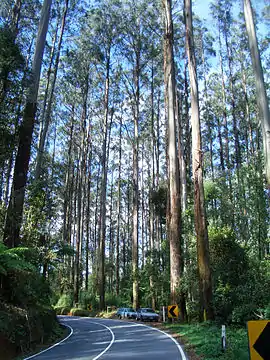Black Spur
The Black Spur is a road between the towns of Healesville and Narbethong in Victoria, Australia. It is also known as Black Spur Drive, and is part of the Maroondah Highway.[1]
The Black Spur Black Spur Drive | |
|---|---|
 | |
Mountain Ash (Eucalyptus regnans) along the Maroondah Highway on the Black Spur | |
| General information | |
| Type | Road |
| Length | 30 km (19 mi) |
| Major junctions | |
| Southwest end | Healesville |
| Northeast end | Narbethong |

Location
The Black Spur is located about 60 km. east-north-east of Melbourne, on the Maroondah Highway, between Healesville and Marysville. To reach the Black Spur, you have to travel along the Eastern Arterial to Ringwood Bypass, then turn left at Maroondah Highway until you arrive at Healesville. Alternatively, you can travel through Cardinia Reservoir to Emerald, then to Yarra Junction and Warburton.
Etymology
The road, originally known as "The Blacks' Spur", gained its name from the route taken by displaced Aboriginal people from northern Victoria on their way to a settlement at Corranderrk near Healesville.[2]
History
During the mid-1890s depression the successful Melbourne photographer John William Lindt closed his studio. As early as 1883 he had been exhibiting pictures of the Blacks' Spur, and there he built and moved to a guesthouse ‘The Hermitage’ in gardens set out by his friend Ferdinand von Mueller, and featuring New Guinea tree houses from which he made frequent panoramas of his property and surrounding primeval forest of towering, 30-metre mountain ash. There he continued his photography in a studio 30m x 8m, with a wall glazed in ground glass. In it he photographed guests, of whom he also made outdoor portraits in the bush setting, and projected lantern slides for their entertainment.
In 1913 he collaborated with Nicholas Caire to produce a tourist booklet on the area.[3]
Though he suffered from anti-German sentiment during and after WW1, and had to defend himself when a public meeting was called at the local shire council hall to demand that he be sent to an internment camp, Lindt continued to sell prints from his older glass negatives and from new photographs he took of his forest home, guests in his gardens, and genre scenes, numbers of which are accessible on the sites of State Library of Victoria, State Library of New South Wales, National Gallery of Australia, National Library of Australia, and the National Gallery of Victoria.
In 1925 the Argus reported that Lindt “continues to produce remarkable and most artistic pictures of the beauties of mountain landscape...he is a master of detail.”[4] Aged 81[5] Lindt died of heart failure during disastrous bushfires on 19 February 1926 at the Hermitage, though the buildings survived.[6][7] He was survived by his wife Catherine who continued to run ‘The Hermitage’ guest house before she retired to the city. In the early 1930s, Joan Anderson purchased the property, maintaining it as a guest house until the 1950s after which the condition of the property deteriorated until in 1979 it was sold and restored, and reopened as a guest house in 1988.[8]
In 2009, a large section of Black Spur was damaged during the Black Saturday bushfires.
In 2019, Melbourne woman Angie Suryadi was killed on the Black Spur when a large tree fell on her family's car during strong winds. Her four year old son was injured.[9]
Description of road
The road is excellent after its resurfacing in August 2006 with smooth hot-mix and road widening that also took place later that same year. It is twisty with a series of hairpin turns punctuated by short straights. A few corners are prone to dampness due to the ferny rainforest surroundings. The scenery is beautiful with tall mountain ash trees and tree ferns, the typical of southeastern Australia's temperate rainforests.
Statistics
- Length (km): 30 (about
- Corner Ratio: 80%
- Corner Speeds: 35–60 km/h
- Legal Speed Limit: 80 km/h
- Traffic (cars/min): 2–5
- Bumpiness: Smooth some corrugation
- Bitumen Grip: Very grippy
- Special Notes: Rainforest means often damp and bark on road in winter and firestorms in summer.
Street Racing
The road is a known as a Tōge-racing spot where amateur racers, often in tuned/modified cars, are driving back and forth at high speed late at night.
In March 2008, the Victorian state government allocated $547,000 to improve road safety on the Black Spur. Stage 1 of the works has involved reducing the speed limit from 100 km/h to 80 km/h, effective Thursday 29 May 2008.[10]
See also
![]() Australian Roads portal
Australian Roads portal
References
- Visit Victoria. "Black Spur Drive". Tourism Victoria. Archived from the original on 19 October 2013. Retrieved 27 April 2014.
- "Archived copy". Archived from the original on 29 August 2009. Retrieved 17 October 2009.CS1 maint: archived copy as title (link)
- McDonald, Roger (2009), Australia's wild places, National Library of Australia, ISBN 978-0-642-27671-1
- The Argus, 19 March 1925
- M. McLardy, ‘Our oldest living photographer’, Australasian Photo-Review, Sept 1947
- Valerie Frost, 'Lindt, John William (1845–1926)', Australian Dictionary of Biography, National Centre of Biography, Australian National University, Volume 5, (MUP), 1974
- "No title (Bushfire) | J. W. LINDT | NGV | View Work". www.ngv.vic.gov.au. Retrieved 1 March 2020.
- "The Hermitage". Heritage Council of Victoria. Retrieved 29 February 2020.
- "BOM weather warning for Victoria, New South Wales and South Australia as winds and snow hit". ABC News (Australia). 9 August 2019.
- "Yarra Ranges' cops in camouflage". State Government of Victoria. Yarra Valley Leader. 31 March 2008. Retrieved 2 June 2008.
External links
- Motorcycle Sports Touring Club of Victoria Inc.
- Black Spur Drive – Official government tourism website
- Black Spur Motorbike Ride
- Black Spur at Google Maps.